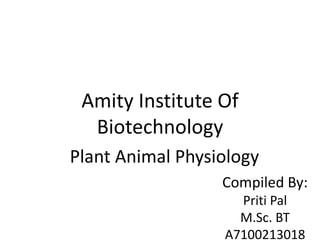
circulation
- 1. Amity Institute Of Biotechnology Plant Animal Physiology Compiled By: Priti Pal M.Sc. BT A7100213018
- 3. Circulatory System • Three basic components: • Heart: The pump • Blood vessels: The passageways • Blood: The transport medium
- 4. THE CIRCUIT OF BIOOD FIOW • Right half of heart receives blood • Left half receives and pumps oxygenated blood • Blood returning from the systemic circulation (deoxygenated) enters the right atria via two large veins: superior and inferior venae cavae
- 5. • The deoxygenated blood from the• The deoxygenated blood from the right atrium then gets pumped into the right ventricle • From there, it’s pumped out through the pulmonary artery – It immediately forms two branches, one going to each lung • In the lungs, blood picks up O2 and drops off CO2 • Then it’s returned to the left atrium via the pulmonary veins • **Only case where veins carry oxygenated blood and arteries carry deoxygenated blood** • Aorta is the single large artery carrying blood away from the left ventricle to the body organs The Circuit of Blood Flow
- 6. • Right side of heart receives blood from the systemic circulation and pumps it into the pulmonary circulation • Left side of heart receives blood from the pulmonary circulation and pumps it into the systemic circulation The Circuit of Blood Flow
- 8. Pulmonary circulation • Blood enters superior and inferior vena cava which is then received by right atrium. • The opening of inferior vena cava into right atrium has valve but the opening of superior vena cava does NOT have a valve. This is because the inferior vena cava must work against gravity whereas the blood in superior vena cava is moved by the help of gravity. • Blood from right atrium is DIRECTED into right ventricle by opening of tricuspid or right atrioventricular valve. The pulmonic valve is closed at this time. • Blood from right ventricle is then DIRECTED into pulmonary trunk via pulmonic valves that are open. At the same time, the tricuspid valve is closed. The closing of this valve is directed by muscles in right ventricle (called papillary muscles). • Blood from pulmonary trunk moves through pulmonary arteries to lungs. Note that the blood in pulmonary artery is deoxygenated. The oxygenated blood is picked up by pulmonary veins and returned to left atrium.
- 10. Systemic Circulation • (from previous slide)…blood in left atrium is oxygenated. This blood is directed into left ventricle by mitral or bicuspid valve. During this stage the aortic valve is closed and right ventricle is filling with blood (diastole). • Blood from the left ventricle is then directed into aorta by aortic valve (open during ventricular systole). The mitral valve is close at this time so that left atrium may collect blood from pulmonary veins. • The aorta has three parts: Ascending part, Arch, and Descending part. • The ascending part delivers blood to the heart itself via the coronary arteries. • The arch of aorta delivers blood to head, neck, and upper extremity. • The descending part delivers blood to everything below the level of heart. Consider: How would the pressure in systemic circulation differ from pressure in pulmonary circulation? Is there any difference?
- 12. Differentiate between systemic and pulmonary circulation • The pulmonary circulation takes deoxygenated blood from the right ventricle to the air sacs of the lungs and returns oxygenated blood from the lungs to the left atrium • The systemic circulation takes oxygenated blood from the left ventricle through the aorta to all parts of the body, including some lung tissue (but does not supply the air sacs of the lungs) and returns the deoxygenated blood to the right atrium.
- 13. Different between systemic and pulmonary circulation • The pulmonary and systemic circulations differ from each other in several more ways. – Blood in the pulmonary circulation is not pumped so far as in the systemic circulation and the pulmonary arteries have a larger diameter, thinner walls, and less elastic tissue. – resistance to blood flow is very low meaning that less pressure is needed to move blood through the lungs. – normal pulmonary capillary hydrostatic pressure is lower than systemic capillary hydrostatic pressure which tends to prevent pulmonary edema
- 14. Thank you